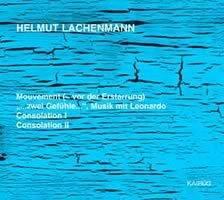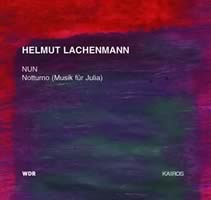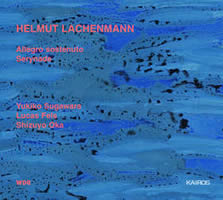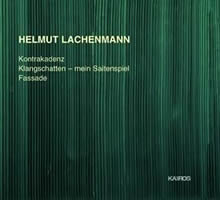Helmut Lachenmann on Kairos
|
Mike Silverton [February 2003.] Breakfast by the kitchen bay, FM tuned to Maine Public Radio, Schumann’s Symphony No.3. Once again, for the first time in this cozy, sunlit nook, the listener ponders his place. Does he immerse himself body and soul in a Romantic masterwork’s treasures or, standing apart, savor its period charms as one might a genre painting? And what are they exactly, these treasures and period charms? Are they conflatable with Geist, or better yet, the spirit locked within a Zeitgeist Schumann helped shape? The grandeur, the heroics, the tender hubris of it all: symphony as saga of a sublime and triumphant Narcissus. Spirit locked within: an aspect of an era, a scrap of reliquary-encased divinity. Time was, the music lover absorbed these aspirations to godhead as if life-lessons: the composer proposing what we might be. The discovery’s been made: the irony of distance and its death’s-head grimace. To attempt in new music a literal revival of the Romantic sensibility as, most typically, an evasion of modernism’s ear-burn astringencies yields spineless freaks and bric-a-brac. Up here in High Culture Country (snicker, snicker), accessibility translates to fraud. Hold the snickers and easy on the sauerkraut. In his Faust Cantata, “Seid nüchtern und wachet” and opera to follow, Historia von D. Johann Fausten, Alfred Schnittke has an amplified chanteuse (Satan in a slinky sheath) reporting on Faust’s demise. I’ll never hear a tango the same way again. By and large modernist composers who forage for grist in art music’s past are into a game that, with difficulty, ascends from mere cleverness. Authenticity, withal, cannot play to the gallery. Wolfgang Rihm, operating within in a vastness of kitsch, highbrow and low, makes music that resonates in its unique way with the Romantic sensibility. Sofia Gubaidulina, a genuine Romantic of mystical bent, understands that sentiment is one thing, its armature another. That their music works as well as it does is the miracle. Gubaidulina’s Offertorium, a violin concerto, is a masterpiece. Like Messiaen and lesser lights, Gubaidulina clings to the Promise of Eternity. In sharpest contrast, Helmut Lachenmann operates a secular train of thought nihilistic-morose from engine to caboose. About Mouvement ( — vor der Erstarrung) — Movement ( — before paralysis) — a 1982 / 84 work for instrumental ensemble, the composer writes, “A music of dead movements, pseudo-activity [consisting] of nothing more than rubble .” If we may depart from the railway metaphor, the man’s bleakness has legs, and they continue to kick and churn. In the notes to NUN, a cryptically titled and rather amazing work for concertante trombone, orchestra and male voices (1999), he is quoted thus: “My dream is the dream of free arrangement, the dream of the ‘lucky hand,’ the dream of unbroken composing. I want to ‘sing as the bird sings that lives in the branches’ however, we are living in the branches of a dying forest.” How does one apply the bad news? As a letter to the editor? “Deluded Sir, I am a gifted composer who, seeing that all lies beyond hope or repair, has decided to write no music whatever. My contribution to the culture of our degraded, end-of-everything age consists of absence — and of course this frivolous letter. It will do for a manifesto. Skimpy, yes, but more than we deserve. Wishing you well in the imminent implosion, Helmut Lachenmann.” Forgive the conceit. Here’s the other-than-fanciful question: Why would I, a free-floating sybarite, be writing about Lachenmann were he other than an engaging composer? To amend Professor Higgins’ quip, it doesn’t much matter what you write music about so long as you do it well. Lachenmann’s audience is necessarily small. As Stendahl might have put it, To the properly despairing and therefore smugly knowing few. With respect to the sorting of one’s responses in terms of satisfactions, let’s think less of irony and more about puzzlement, or to inflate an indecision, what it is that tickles our musical fancy. I’ve listened to a lot of Lachenmann on recording and judge certain compositions superb, others less so, others still, inadequately focused. (The composer makes demands on one’s time. Minute Waltzes need not apply.) The possibility of attending unexampled aural assemblages and arriving at preferences is, I should think, a matter of some interest. I mean, when the rhetoric devolves to autism, what is it that one listens for? The answer need not be so convoluted as to evade understanding. This is, in fact, about understanding with respect to the mind’s need (or canny ability) to create connections. It may be as simple as that: with respect to formally organized sounds, an abiding desire for linkage. The animist connects the very pebbles in the brook to the characters populating his cosmology. The temperamentally antipodal John Cage provides an insight by way of aleatory composition. If one determines to remain available to suggestion, he cannot listen to music however randomly assembled without detecting discourse. Call it relatedness, call it connectivity. Call it lycanthropy, call it Camembert — it happens. Conversely, I am forever amazed by the astonishingly narrow prejudices people bring to music. My wife and I had company the other night. I played something of a sweet and gentle nature that sat on our guests’ ears like EMF from outer space. As a tribal marker, as a trigger to the phooey-whoopee response, music can be as potent as religion. One doesn’t say to guests over coffee and dessert, “Do you accept Jesus as your personal savior?” any more than you’d suggest a nice, after-dinner session with Lachenmann on recording. Like reading, the perception of music occurs in time. The analogy collapses at a page’s line-endings, where the eye is obliged to drop to the next. Rather than scanning regularly measured lengths in space, the ear hangs on sounds, alert to relationships, perhaps even creating relationships — amplifying, extrapolating, bridging, pivoting identities — akin to sentences and paragraphs. Music articulates in the sense of the body’s joints as, for example, test-tones don’t, pace Alvin Lucier, whose music can sometimes seem like a test tone, but isn’t. And therein dwells the magical difference: That gadfly isn’t. Indeed, but that’s me. Whether music is articulate in the sense of eloquent is up to you and my politely indifferent dinner guests.
The writer assumes a certain degree of community with his reader, which is only to say, you’ve come this far. Remaining with Movement ( — before Paralysis), dynamically subtle over much of its span, its essence, as I hear it, is restive and mordantly funny. (Because I read the notes? A question not to be sneezed at.) Lachenmann sets out to enclose — encounter, reflect upon, toy with, interpret — a collapsing culture. About 16 minutes in, we come upon a patch vaguely suggestive of an old-fashioned, gemütlich gallop, which runs out of steam (rather, say, than nuclear power), thence to a whispered, creaking exhaustion. The piece reminds me a little of those God Is Dead and End of History pronouncements. Like Richard Strauss in his Metamorphosen, Lachenmann stands in a cul-de-sac where he fashions a poetry as much reflective of its time as Schumann’s. Let’s recall that Schumann went mad, which is why, I suspect, more than a few edge-dwelling moderns, Germans especially, revere his memory and art. “We and our spiritual forebear and the brick walls we run into.” There are streets leading elsewhere, and of course Lachenmann knows it. Strauss’s was a late-19th-century sensibility. Lachenmann’s arose from the mid-20th’s avant-garde, where, to depart for a moment from music, painters made critically successful careers of repeated, narrowly focused gestures, e.g., Barnett Newman’s solo stripes. But we cannot see Newman’s one-trick pony as expressions of despair. The stripes are uplifting, particularly the vertical ones. Michael Finnissy has this to say about his own Lost Lands (Metier MSV CD92050, http://www.metierrecords.co.uk/): “These [six] pieces are recycled waste. They do not, however, concentrate exclusively on the ‘dead area’ wastage of ostinati, oompah bass-lines or sequences of diminished sevenths. They variously collect together the detritus of musical cultures potentially obliterated by ethnic cleansing (in Kurdestan and Azerbaijan) or styles and genres (Expressionism, an eroticised Modernism, Free Jazz) dismissed as obsolete or commercially unsustainable.” This rummaging about the municipal dump appears to be the thing to do. Analogies are by nature unreliable. It requires but a moment to take in a Newman stripe. Mouvement’s recording plays for 22:27, Lachenmann’s palette abounding in riches, compared, say, with the illuminating frugality of Morton Feldman’s or that of the fatally blinkered Minimalists. In grade school, my music-appreciation teacher, in introducing the idea of program music, observed that the Nutcracker’s “Waltz of the Flowers” could as easily describe a sail on the Hudson (or anything short of a saunter to the gibbet). If you can provide the tune to “This is the sym-pho-nee that Schubert wrote and never finished,” you’re a lot older than you want to be. Music appreciation: The very words raise sepia-tinted mists and indeed controversy, should we choose to measure its then content by today’s multicultural standard (an oxymoron if ever one was). Let’s simply agree that those were simpler times, at least with respect to the perception of classical music — “good” music, “serious” music — as superior stuff: a given, like Popeye’s can of spinach. It’s nourishing and may even prompt wonders. Wonders, yes, they never cease. Having survived the 20th century, we understand, perhaps to our regret, that “good” music exercises scant moral authority. Nor do I hear Lachenmann as a moralist. A composer of a certain cast of mind looks about, observes (or determines) his place and reflects upon it in his music. The listener need not abide by inference in order to derive pleasure from what he hears. “Excuse me, sir. Did you say pleasure? With Lachenmann, pleasure? As in, say, an amusing toothache?” But that’s the great thing about music: We hear what we hear, and what we hear gets filtered through a brain, and Lachenmann’s gorgeously crafted subversions rarely fail to fascinate. Before we go on, here are the four Kairos CDs behind these remarks. NUN, for Flute, Trombone, Orchestra and Men’s Voices (1997-99). Notturno (Musik für Julia), for Small Orchestra and Cello (1966-68). Gaby Pas-Van Riet, flute; Michael Svoboda, trombone; Neue Vocalsolisten Stuttgart, WDR Symphony Orchestra, Köln, Jonathan Nott, conducting. Kairos 0012142KAI. Mouvement ( — vor der Erstarrung) for Ensemble (1982 / 84). “ … zwei Gefühle ,” Music mit Leonardo, for Two Speaking Voices and Ensemble (1992). Consolation I, for 12 voices and four percussion (1967 / 90). Consolation II, for 16 voices (1968). Klangforum Wien, Hans Zender, conducting. Schola Heidelberg, Ensemble Aisthesis, Walter Nussbaum, conducting. Kairos 0012202KAI. Allegro sostenuto, Music for Clarinet / Bass Clarinet, Cello and Piano (1987 / 88). Serynade, for Piano (1998 / 2000). Shizuyo, clarinets; Lucas Fells, cello; Yukiko Sugawara, piano. Kairos 0012212KAI. Kontrakadenz, Music for Orchestra (1970 / 71). Klangschatten — mein Saitenspiel, for 48 Strings and Three Concert Grands (1972). Fassade, Second Music for Orchestra (1973, rev.1987). Peter Rogenkamp, Zsigmond Szathmáry, Gerhard Gregor, pianos. SWR Radio-Symphony Orchestra, NDR Symphony Orchestra, Michael Gielen, conducting. Kairos 0012232KAI. I had every intention of commenting on what I find of particular interest in each release. The task lies well beyond my abilities. One has the choice of offering a cubic yard of vague impressions or going into as much jargon-laden detail as he can manage. Either way, given the music’s language-defying qualities, it’s not a jolly prospect. Elvis Costello’s bon mot has never had a better home. I paraphrase: “Writing about Helmut Lachenmann’s music is like dancing about architecture,” though “dancing about ear-sculpture” would perhaps put it better. This, however, is easy enough: From the earliest pieces in these four wonderfully well-programmed and -recorded CDs to the most recent, developments in sound-management aside, it’s obvious that Lachenmann has turned his back on what we understand musical discourse to be in an attempt to create, largely successfully, beauty from other than beautiful sounds. He works his genius on music’s coughing, gasping casualties and the shrapnel and shards that brought them down: dramatic always, by way of intensity, contrast, silence. Lachenmann is rarely slack or obviously didactic or polemical. (His writings are another matter). Neither is he a satirist nor spiritual in any of the religio-mystical ways we’ve been conditioned to expect in modernist art music. The alchemy is earthbound, agnostic and hallucinatory.
In terms of motivation in the sense of overview, Lachenmann’s Allegro sostenuto of 1987 / 88, for clarinet / bass clarinet, cello and piano, offers a panoramic perch. For a start, with its exquisitely etched lines, it’s an engaging piece, though long and characteristically dilatory: To say it again, the composer does make demands on one’s concentration. If it’s a question of what something’s “about,” it wouldn’t be unfair to characterize Allegro sostenuto as a wide-ranging, multi-faceted investigation into attacks and decays. But more than that — above all else — we’ve the quite perfect exemplar of a hugely gifted artist collecting the debris of a shattered high culture and, in no strict order of precedence, fashioning a brilliant mosaic. Lachenmann’s music is nothing if not brilliant in the light-reflecting and brain-wave sense. However degraded the milieu, the creative mind will find a way, if not out, past obstacles lesser colleagues negotiate badly or not at all. I’d recommend starting with Allegro sostenuto. If that does it for you, I urge you to acquire the others in this listing. Each CD contains at least one gem, and — audiophile alert! — the recorded sound is remarkably good, as are the performances. The label’s Website is http://www.kairos-music.com/. Kairos’ American distributor is Albany Music at http://www.uncommonlyclassical.com/.
[More Mike Silverton]
[More
Lachenmann]
[Previous Article:
Of Time and the River: B.A. Zimmermann, Mario Pagliarani]
[Next Article:
An Eclectic Stringed Ramble]
|



